-
PDF
- Split View
-
Views
-
Cite
Cite
R. Rathulnath, Chanda J. Jog, Dynamics of prolate spheroidal mass distributions with varying eccentricity, Monthly Notices of the Royal Astronomical Society, Volume 433, Issue 1, 21 July 2013, Pages 719–729, https://doi.org/10.1093/mnras/stt759
Close - Share Icon Share
Abstract
In this paper we calculate the potential for a prolate spheroidal distribution as in a dark matter halo with a radially varying eccentricity. This is obtained by summing up the shell-by-shell contributions of isodensity surfaces, which are taken to be concentric and with a common polar axis and with an axis ratio that varies with radius. Interestingly, the constancy of potential inside a shell is shown to be a good approximation even when the isodensity contours are dissimilar spheroids, as long as the radial variation in eccentricity is small as seen in realistic systems. We consider three cases where the isodensity contours are more prolate at large radii, or are less prolate or have a constant eccentricity. Other relevant physical quantities like the rotation velocity, the net orbital and vertical frequency due to the halo and an exponential disc of finite thickness embedded in it are obtained. We apply this to the kinematical origin of Galactic warp, and show that a prolate-shaped halo is not conducive to making long-lived warps – contrary to what has been proposed in the literature. The results for a prolate mass distribution with a variable axis ratio obtained are general, and can be applied to other astrophysical systems, such as prolate bars, for a more realistic treatment.
INTRODUCTION
A galactic disc is believed to be embedded in a dark matter halo, but the actual shape of the dark matter halo is not yet well understood. Usually, the halo is taken to be spherical for simplicity, or oblate. When a deviation from sphericity is considered at all, typically an oblate shape is used (e.g. Sackett & Sparke 1990). A prolate halo has been used in a few cases, e.g. to study warps in galaxies (Sparke 1984; Ideta et al. 2000), and to explain the tidal streaming in the Galaxy (Helmi 2004). In these the axis ratio is taken to be constant, again for simplicity.
Recently, it was shown that the dark matter halo in the Milky Way is prolate with the vertical-to-planar axis ratio monotonically increasing to 2.0 at 24 kpc (Banerjee & Jog 2011). This was obtained by modelling the observed steeply flaring atomic hydrogen gas layer in the outer Galaxy, where the gas is supported by pressure against the net gravitational field of the disc and the halo. It is then natural to ask what would be the dynamical consequences of such a progressively prolate halo. This is the motivation for the present paper.
N-body simulations of galaxies show that the dark matter halo is triaxial. Along the Cartesian cuts (X–Y or X–Z), the haloes show a range of value from oblate to prolate with a preference for a prolate shape (Bailin & Steinmetz 2005; Bett et al. 2007; Vera-Ciro et al. 2011). Further the axis ratio varies with radius. Indeed, there is no simple physical reason why the shape should be constant with radius. Thus a radially variable axis ratio for an ellipsoidal mass distribution is not just of academic interest but of practical use for a study of dark matter haloes, and in other astrophysical systems as well.
To study the dynamics of a prolate halo, we need to first calculate its potential and other physical quantities. Mathematically this reduces to the problem of inversion of Poisson equation for a given density distribution. This is a rich and an old subject, which had attracted the attention of mighty mathematicians like MacLaurin, Lagrange, Jacobi, Gauss to name a few (e.g. Rohlfs 1977), also see Chandrasekhar (1969) for details. Yet, interestingly, the calculation for a prolate case with varying eccentricity has to our knowledge not been studied in the literature so far.
Motivated by this, in this paper we study prolate ellipsoidal mass distributions with an eccentricity that varies with radius. The ellipsoids are taken to be concentric and coaxial or coplanar. We show that the constancy of potential within a shell as in homoeoids is a good approximation even when the shell is bounded by dissimilar ellipsoids, for small variation in the eccentricity as seen in realistic systems. This is an important general result from this paper.
We calculate the potential for a general density distribution by adding the shell-by-shell contributions from isodensity surfaces from shells internal and external to a point, and from this obtain the radial and planar force equations and frequencies. Next, these results are applied to the specific case of pseudo-isothermal density distribution for the dark matter halo, and an exponential disc of finite thickness, to study the longevity of the Galactic warp for a disc in a prolate halo. We show that the prolate halo does not result in a long-lived warp, contrary to the literature where a prolate halo (Ideta et al. 2000) or a halo with a radially variable shape (Binney & Tremaine 1987) have been suggested to explain long-lived warps.
The calculation of the potential and related physical quantities is given in Section 2. In Section 3 this is applied to toy mass models so as to study the properties of a prolate spheroidal system. In Section 4 we apply this to the Milky Way and study the effect of the prolate halo on the warp and show that the halo does not yield long-lived warps. Section 5 summarizes our conclusions.
The reader who is mainly interested in the application of a prolate halo to the study of warps, may wish to skip the technical material involving potential theory in Sections 2 and 3, and go directly to Section 4.
POTENTIAL OF A PROLATE ELLIPSOID WITH VARYING ECCENTRICITY
The dark matter halo is usually modelled as a spherical or oblate distribution of constant ratio, for simplicity (e.g. Sackett & Sparke 1990). In a rare case, an oblate mass distribution with radially varying axis ratio has been studied (Ryden 1990) in the quadrupolar limit, and extended for the prolate case by Buote & Canizares (1996) in the same limit. The general case of a prolate spheroidal mass distribution, in particular with a varying axis ratio, has not been studied in the literature so far. The potential for a general triaxial case (with constant axis ratios) is stated in Binney & Tremaine (1987) without derivation, and has been derived in Chandrasekhar (1969), and by de Zeeuw & Pfenniger (1988). From this one can derive the potential for a prolate spheroid of constant axis ratio, as for example was done by Das & Jog (1995) for modelling bars in a study of heating due bars.
In this paper, we give the analytical calculation of the potential and other relevant physical quantities of a body for which the isodensity surfaces are prolate in shape with radially varying eccentricity. In this way of formulation of the problem, the case of a constant axis ratio comes out naturally as a simple case of the general calculation, as shown later in this section. First the potential due to a prolate spheroidal surface is calculated, following the approach developed for an oblate spheroidal surface by Binney & Tremaine (1987). Then by summing over the contribution by the various shells, the net potential is obtained.
Potential of a prolate spheroidal surface
Potential of prolate mass distribution
The potential due to a prolate spheroidal surface is obtained above (equation 10). A prolate spheroidal mass distribution can be considered as the combination of such surfaces, with the condition that the isodensity surfaces should not intersect each other. This is so that the function is not unphysical or double-valued. Then we can calculate the potential of such distributions using equation (10).
This scale factor denotes the deviation from the case of constant internal potential. We show in Appendix A that the values of S are small for the small variation in eccentricity with radius considered here. Thus, interestingly the homoeoidal potential theory though not rigorously valid, is still a good approximation. Hence the potential within a shell (u < u0, see equation 10) can be assumed to be constant even for the case of a shell bounded by dissimilar spheroids. In analogy with a homoeoid which is a shell bounded by two similar spheroids, we define a heteroid to be a shell bounded by two dissimilar spheroids. In this paper we study the gravitational potential and force due to a heteroid.
In the limit of a constant axis ratio, σ = 0, hence the above expression simplifies to the result for the prolate spheroidal mass distribution of a constant shape.
Related physical quantities
Using the above expression for the potential, we next obtain other relevant physical quantities such as the force components along R and z, and the angular and vertical frequencies at the mid-plane for a particle in this potential. These are applied to the particular problem of warps in Section 4.
Angular frequency, Ωh
Vertical frequency, νh
APPLICATION FOR VARIOUS MODEL MASS DISTRIBUTIONS

Isodensity contours in a plane containing the polar axis for a prolate spheroidal mass distribution with an axis ratio that is (a) constant, (b) increasing and (c) decreasing with radius.
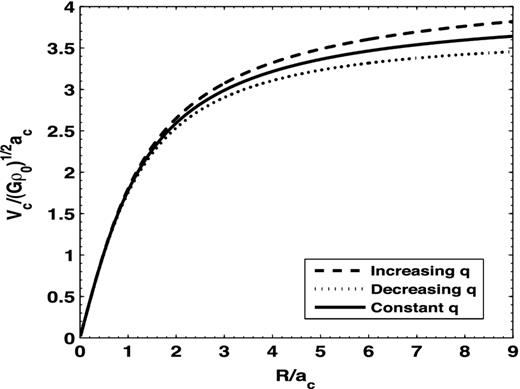
The rotation velocity for a pseudo-isothermal prolate-shaped halo density distribution with an axis ratio that is constant (q = 1.5), increasing (q = 1.5–1.9) and decreasing (q = 1.5–1.2) with radius.
For density profiles with a varying axis ratio, Ωh and νh are calculated numerically. Fig. 3 shows the pattern speed curves of different distributions: the pattern speed decreases at different rates with radius and approaches zero at large radii. For each axis ratio considered, the mass distribution near the mid-plane is different which mainly determines the rate of fall of the pattern speed curves. The important result to note from Fig. 3 is that for a prolate halo the pattern speed is >0, that is, Ωh > νh. In contrast, for a flattened disc or an oblate halo, the reverse is true (e.g. Binney & Tremaine 1987). The net value of the pattern speed is determined by taking account of the contribution from the galactic disc also, as will be discussed in Section 4.
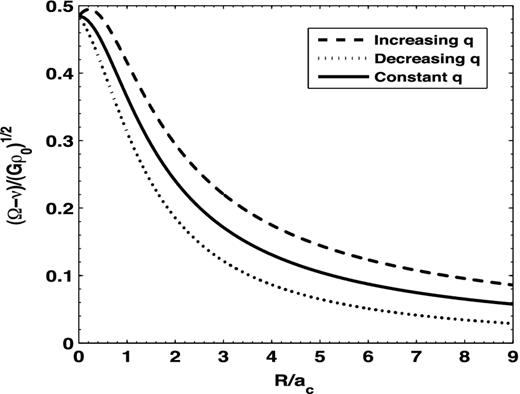
The pattern speed for the halo-alone case, for a prolate-shaped halo density distribution with an axis ratio that is constant (q = 1.5), increasing (q = 1.5–1.9) and decreasing (q = 1.5–1.2) with radius.
APPLICATION TO WARP IN THE GALAXY
Here we apply the results obtained in Section 2 to the particular case of the Milky Way to study the pattern speed and winding in the Galactic warp. The aim is to see what effect a progressively prolate halo has on the winding time of a warp.
In the past it has been suggested that a prolate halo (Ideta et al. 2000) or an oblate halo with an eccentricity that changes with radius (Binney & Tremaine 1987) can help in making warps long-lived. The severity of the winding problem depends on the differential precession rate or on how rapidly the pattern speed changes with radius. In the kinematical picture of warps, the pattern speed for the slow mode is given by Ω − ν (Section 3). We need to calculate the contribution to this both from the disc and the halo. In a disc, the pattern speed is negative since ν > Ω for a gravitating disc, while for a spherical halo the two are equal, and for a prolate halo the reverse is true, namely, ν < Ω. Thus it can be seen that adding a prolate halo may help sustain a warp. Qualitatively this was the motivation for trying a prolate halo in the present paper.
Vertical and angular frequencies due to Galactic disc
Disc and halo parameters for the Galaxy
For the Galaxy, the radial disc scale length Rd = 3.2 kpc (Mera et al. 1998) and zd = 0.35 kpc (Binney & Tremaine 1987) are used for calculating the force components and the frequencies given above. The mid-plane volume density of the stellar disc at the solar neighbourhood is observed to be 0.07 M⊙ pc−3 (Binney & Tremaine 1987). Substituting the values of Rd, zd and ρ at solar neighbourhood in equation (47), we get the value of the central density, ρ(0, 0) ≈ 0.99 M⊙ pc−3.
Three types of halo distributions are considered.
A pseudo-isothermal spherical distribution as in equation (40), obtained in the Galactic mass model by Mera et al. (1998), where ρ0 = 0.035 M⊙ pc−3 and ac = 5 kpc.
- A prolate spheroidal distribution with an increasing axis ratio, that is obtained by modelling the steep flaring of H i in the outer Galaxy (Banerjee & Jog 2011); where axis ratio q and the halo density ρ(a) are given, respectively, byand(53)\begin{equation} q = 1+\alpha _1\,(a-9)+\alpha _2\,(a-9)^2\ \mbox{when}\ 9 \le a\le 24\,\mathrm{kpc} \end{equation}where q = 1 when a ≤ 9 kpc, and the constants α1 = 0.020 and α2 = 0.003, and ρ0 = 0.035 M⊙ pc−3 and ac = 5 kpc.(54)\begin{equation} \rho (a)=\frac{ {{\rho _0}/\left[{1+{(\frac{a}{a_{\rm c}})}^2}\right]}}{q}, \end{equation}
- A prolate shape with a constant axis ratio, q = 1.9: we change the shape of the dark matter halo from a sphere to a prolate spheroid by keeping the semiminor axis fixed such that the total mass inside does not change. Thus equating the mass inside both spheroids, one can find out the value of the core radius ac for the prolate spheroid. The mass enclosed by the prolate spheroid of semiminor axis a isEquating this with the mass inside a sphere (i.e. M(q = 1)) of radius ac, gives the value of ac as a function of q:(55)\begin{equation} M({<}a)=4{\pi }G\rho _0a_{\rm c}^2q\left(a-a_{\rm c}\arctan \left(\frac{a}{a_{\rm c}}\right)\right). \end{equation}Equating the terminal velocities of the prolate spheroid (equation 43) and of the sphere gives the value of ρ0(q):(56)\begin{equation} \frac{a_{\rm c}(q)}{a_{\rm c}(1)}\arctan \frac{a_{\rm c}(1)}{a_{\rm c}(q)}=1-\frac{4-{\pi }}{4 (q^2-1)^{1/2}}\,\frac{1}{2} \ln \left(\frac{1+e}{1-e}\right). \end{equation}where ac(1) = 5 kpc and ρ0(1) = 0.035 M⊙ pc−3 for the spherical case (q = 1) (Mera et al. 1998). For q = 1.9, this gives ac = 5.98 kpc and ρ0 = 0.016 M⊙ pc−3. For another typical value, q = 1.5, we get ac = 5.57 kpc and ρ0 = 0.021 M⊙ pc−3.(57)\begin{equation} \frac{\rho _0(q)}{\rho _0(1)}=\frac{a_{\rm c}^2(1)}{a_{\rm c}^2(q)}\,\frac{({1-q^2})^{1/2}}{q}\,\frac{1}{\frac{1}{2} \ln \left(\frac{1+e}{1-e}\right)}, \end{equation}
Pattern speed for warp
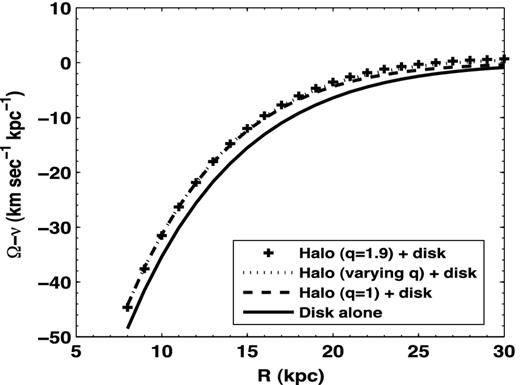
The pattern speed of warp in the Galaxy consisting of an exponential disc of finite height and dark matter halo of different shapes and distributions. Clearly, the halo contribution to the pattern speed is negligible.
Winding time
Comparison with previous work
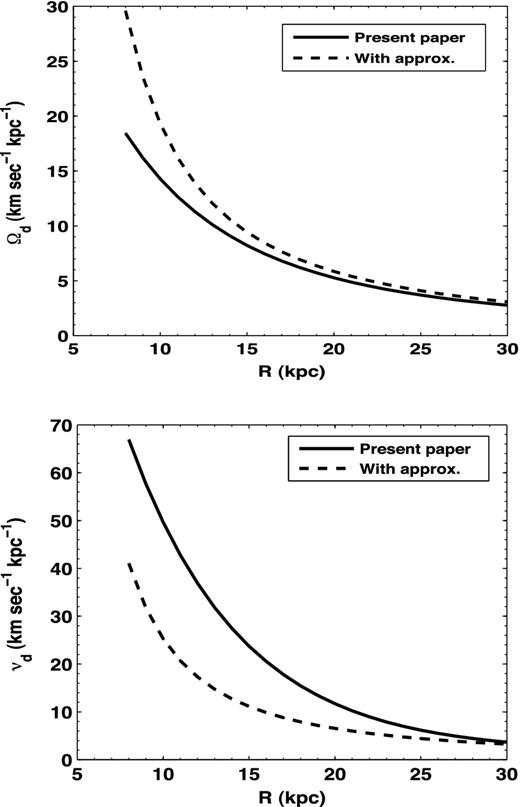
Ωd and νd versus R for a particle in the Galactic disc using the correct treatment as in this paper (solid line), and using the approximation of an infinitesimally thin disc and potential valid at large radii as in Binney & Tremaine (1987) (dashed line).
In this approximation, ν and Ω have comparable values – we note that this result is incorrect, since it is well known that within a self-gravitating disc ν > Ω. Check that the correct treatment for a finite height disc in the present paper does satisfy this criterion (see Fig. 4 which shows Ω − ν < 0), which results in a pattern speed that varies rapidly with radius and is dominated by the disc contribution (Fig. 4).
Fig. 6 shows results for the pattern speed of warp at the galactic plane for a prolate halo of q = 1.9 and the correct treatment for the disc as in this paper (the solid line), and it also shows the erroneous results obtained using the approximation for the disc (equation 62) either by itself, or with a spherical halo, and the logarithmic halo as in Ideta et al. (2000). The last three cases, in particular the one with the prolate halo, show an almost constant pattern speed throughout the range of radii of interest where the warp is seen. This led Ideta et al. (2000) to the conclusion that a prolate halo results in a Galactic warp that can be sustained for more than the Hubble time. To summarize, they arrived at this wrong conclusion due to the use of an approximate expression for the potential for an infinitesimally thin disc as applied to a low radial range where it is not valid.
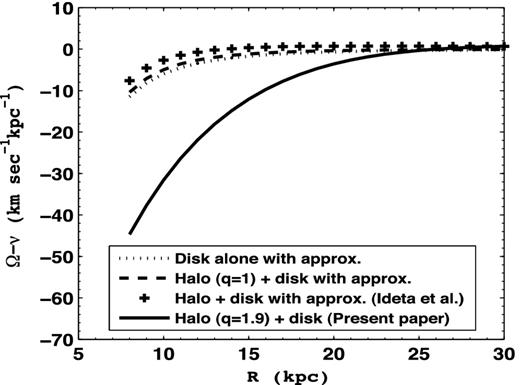
The pattern speed of warp in the Galaxy consisting of a disc of finite thickness and a prolate halo (q = 1.9) from the present paper (solid line), and that using the approximation of an infinitesimally thin disc and potential valid only at large radii (as in Binney & Tremaine 1987; Ideta et al. 2000) and different halo shapes.
The correct treatment for the disc in the present paper shows that the disc contribution to the pattern speed is dominant (solid line, Fig. 6, also see Fig. 4), and that the prolate dark matter halo, indeed halo of any shape, has very little effect on the pattern speed of the Galactic warp. The normalized differential force due to the heteroid shells considered is negligible (<1 per cent, see Appendix A), hence that too cannot affect the above result. In retrospect, this is not surprising, since the previous work on the origin of warps by non-axisymmetric response showed that the radius of onset of warps in a galactic disc depends weakly on whether or not an oblate halo is included or on its shape, as shown for a disc with an exponential vertical distribution (Saha & Jog 2006) or a general z distribution (Pranav & Jog 2010).
We caution that we have only considered a simple kinematical model of warp, as an application of the potential obtained for prolate ellipsoids of varying eccentricity. The latter was the main aim of this paper. A complete treatment of the dynamics and origin of warps would be much more complex and could involve a responsive and triaxial halo (e.g. Binney, Jiang & Dutta 1998; Dubinski & Chakrabarti 2009) and is beyond the scope of this paper.
CONCLUSIONS
In this paper, we have given the analytical calculation for the potential of a prolate ellipsoidal mass distribution with radially varying eccentricity. This is obtained by summing up the shell-by-shell contributions of isodensity surfaces. We define a heteroid to be a shell that is bounded by two dissimilar surfaces. An important result from this paper is that the potential within a heteroid is shown to be approximately constant as long as the radial variation and the range of values of eccentricity spanned are small as in realistic systems. The normalized differential force across such a shell is non-zero but small and does not affect the dynamical stability of such figures on a Hubble time.
The motivation for this work was to see if the progressively prolate halo for the Galaxy (as in Banerjee & Jog 2011) could help sustain long-term warps. We apply the above calculation to the case of Galactic warp, and on using the correct treatment for the disc, find that the disc mainly determines the warp pattern speed. Thus, the dark matter halo has only a marginal effect on the pattern speed, and it does not lead to long-lived warps.
The results for the potential and force components obtained here are general and could be applied for a more realistic treatment of other astrophysical systems such as prolate bars with a varying shape. We also give a similar exact calculation for the oblate case for the sake of completeness. This can be applied to oblate spheroidal systems with varying eccentricity.
We thank the anonymous referee for raising the very important issue about the applicability of the homoeoid potential theory for the case of spheroids of varying eccentricity studied in our paper.
REFERENCES
APPENDIX A: POTENTIAL AND FORCE INSIDE A PROLATE SHELL WITHIN DISSIMILAR SURFACES
In this paper we treat spheroids of radially varying eccentricity. In analogy with a homoeoid which is a shell bounded by two similar spheroids, we define a heteroid to be a shell bounded by two dissimilar spheroids (Section 2.2). We show next that the results from the standard homoeoid potential theory, namely the constancy of potential inside a shell and no net force within it, are good approximations even for the case of a shell with dissimilar surfaces – when the radial variation in eccentricity is small as seen in realistic systems. This is an important general result and to our knowledge the heteroid case has not been studied systematically in the past.
In Fig. A1, we plot the values of this scale factor versus the semiminor axis a/ac normalized with respect to the core radius, for decreasing q (as given by equation 41) with α = −0.1 for the prolate coordinate v = 0 and v = π/2 and similarly for increasing prolateness with q increasing (as given by equation 41) with α = 0.1. This figure clearly shows that the scale factor values are small (<a few per cent). Hence the deviation from the case of similar shells treated in homoeoidal theory is non-zero but small. Thus, interestingly, we find that for the small variation in eccentricity with radius and for the range of q values as considered in this paper – the assumption of a constant potential within a shell is a good approximation even for the case of a shell bounded by dissimilar surfaces.
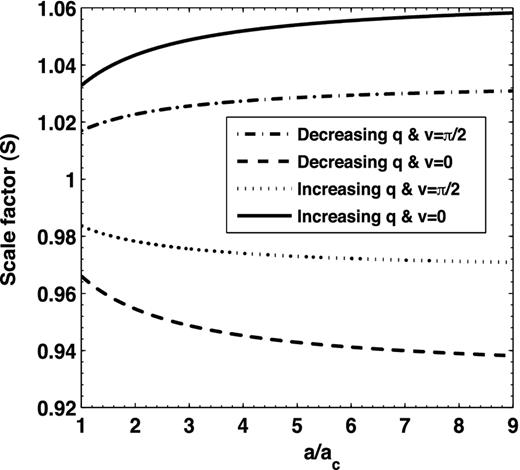
The values of the dimensionless scale factor, S, that denote the deviation of the surface density within dissimilar surfaces compared to the case of similar surfaces versus the dimensionless semiminor axis, for increasing and decreasing prolateness, and for different values of the prolate coordinate v. Note that the deviation from the similar shells corresponding to the usual homoeoidal case is small <a few per cent.
First, check that the force inside of such a shell would be identically equal to zero if the surfaces are similar (homoeoids). Next, we can find out the total differential force at a point (R, z) due to outer dissimilar shells by adding the contributions of each shell. The magnitude of the differential force depends on the eccentricities of ellipsoids which surround the shell. The total differential force at a point is obtained for the density distribution (equation 40) and the eccentricities (equation 41) used in our work, and this is normalized with the force due to a homogenous spheroid which has the surface that is passing through the point (R, z) and has that value of constant density. For normalization, a constant density ellipsoid is assumed for simplicity. The increasing q (more prolate at larger radii) corresponds to α = 0.1 while decreasing q (less prolate at smaller radii) has α = −0.1 (see Section 3). These correspond to a variation in the prolate axis ratio, q = 1.5–1.9 and 1.5–1.2, respectively (Section 3). The increasing case covers the range of values of q similar to the range deduced from flaring of H i data in the outer Milky Way (Banerjee & Jog 2011, also see Section 4.2).
The values for different semiminor axis are given in Table A1. Clearly, the differential force is very small (with magnitudes ≤1 per cent) for the range of semiminor axis values that we are interested in. As expected, the differential force magnitudes are highest at inner radii but still small ∼1 per cent. The typical value of ac, the core radius, is 5 kpc in our Galaxy (Section 4), thus the ratio a/ac = 1–8 corresponds to about 5–40 kpc. Therefore, we can take the internal force due to the spheroids of varying eccentricity to be zero for our calculation. This further confirms that Newton's theorem is a good assumption even for the case of dissimilar ellipsoids considered here. This is an important, general result and can be applied to other realistic cases. For example, this is also applicable for studies of dark matter haloes in simulations which show an even smaller variation in the prolate or oblate axes ratio (e.g. Jing & Suto 2002; Vera-Ciro et al. 2011).
Normalized differential force magnitudes due to a shell within dissimilar surfaces.
| a/ac . | FR . | Fz . |
|---|---|---|
| Increasing q | ||
| 1 | 0.0120 | 0.0018 |
| 3 | 0.0098 | 0.0072 |
| 8 | 0.0023 | 0.0085 |
| Decreasing q | ||
| 1 | 0.0141 | 0.0020 |
| 3 | 0.0128 | 0.0071 |
| 8 | 0.0033 | 0.0072 |
| a/ac . | FR . | Fz . |
|---|---|---|
| Increasing q | ||
| 1 | 0.0120 | 0.0018 |
| 3 | 0.0098 | 0.0072 |
| 8 | 0.0023 | 0.0085 |
| Decreasing q | ||
| 1 | 0.0141 | 0.0020 |
| 3 | 0.0128 | 0.0071 |
| 8 | 0.0033 | 0.0072 |
Normalized differential force magnitudes due to a shell within dissimilar surfaces.
| a/ac . | FR . | Fz . |
|---|---|---|
| Increasing q | ||
| 1 | 0.0120 | 0.0018 |
| 3 | 0.0098 | 0.0072 |
| 8 | 0.0023 | 0.0085 |
| Decreasing q | ||
| 1 | 0.0141 | 0.0020 |
| 3 | 0.0128 | 0.0071 |
| 8 | 0.0033 | 0.0072 |
| a/ac . | FR . | Fz . |
|---|---|---|
| Increasing q | ||
| 1 | 0.0120 | 0.0018 |
| 3 | 0.0098 | 0.0072 |
| 8 | 0.0023 | 0.0085 |
| Decreasing q | ||
| 1 | 0.0141 | 0.0020 |
| 3 | 0.0128 | 0.0071 |
| 8 | 0.0033 | 0.0072 |
Since the typical dynamical time-scale in a homogenous spheroid with a surface at say 3ac = 15 kpc is ∼a few ×108 yr, hence the differential force of <1 per cent of the force due to the inner spheroid is not likely to affect the stability of such a distribution over 100 times the dynamical time-scales or over a Hubble time.
APPENDIX B: OBLATE SPHEROIDAL MASS DISTRIBUTION WITH RADIALLY VARYING ECCENTRICITY
In this appendix, we give the oblate case with varying eccentricity for the sake of completeness, with an approach similar to that developed in this paper for the prolate case. This problem has been looked at earlier by Ryden (1990), who however used the method of multipoles limiting to the quadrupole approximations. Thus Ryden's results are approximate and in particular not rigorous for inner regions, as we check by comparing with the exact calculations below. Hence we give the exact calculation below. This could be of use not just for dark matter halo but also for other systems of varying eccentricity such as bulges.
The method of derivation of physical quantities for the case of oblate spheroidal mass distribution is similar to the method that is described for the prolate spheroidal mass distributions. So the resulting equations of potential, forces, vertical and horizontal frequencies are given here without detailed derivations. The density profile, axis ratio and σ are used as the functions of semimajor axis a. (Remember that in the case of prolate distribution, a is the semiminor axis.) Here the axis ratio is always less than 1.
When the axis ratio varies with radius, the constraint that the shells do not cross is again given by σ(a) ≥ −1, where σ(a) is defined by equation (14), except that a is now the semimajor axis.
Check that the function S defined here is exactly the scale factor as obtained for the prolate case (equation 22). On comparing equations (B3) and (B6), it can be seen that the case of dissimilar spheroids deviates from the similar spheroids by this scale factor. In this case also, the values of the scale factor S would be small. Hence as discussed in the case of prolate mass distribution, we can still apply the homoeoidal potential theory. That is, we can substitute the expression of mass of the shell (equation 15) in equation (B1) to calculate the potential due to a shell which is bounded by two dissimilar oblate spheroidal surfaces.



